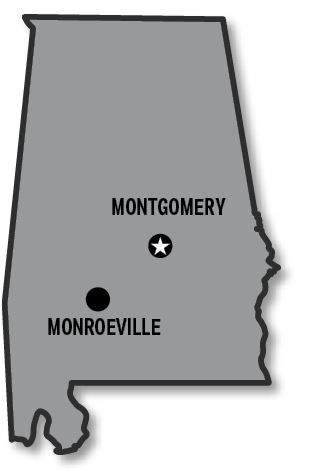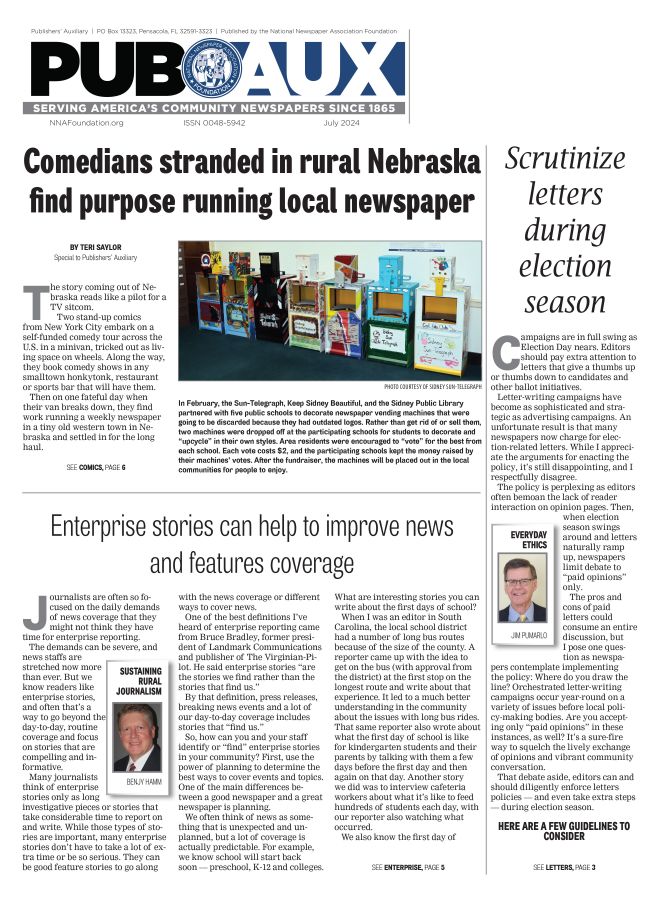In the heart of Alabama’s literary capital, Monroeville Journal is a family’s labor of love
Teri Saylor
Special to Publishers' Auxiliary
Sep 1, 2019

Bo Bolton likes to joke about the time his mother took him and his two brothers to dinner after a University of Alabama football game and encountered one of her former classmates. She introduced one of her sons as “a doctor,” and another as “a dentist,” and when she got to Bolton, she introduced him by his given name, “Kermit” and said, “he throws newspapers for a living.”
Bolton laughs as he explains that when he told his mother he worked for a newspaper, she asked about his job description.
“She asked if I was a writer, and I said ‘no.’ She asked if I sold advertising and I said ‘no,’ and she asked if I worked in production, and I said ‘no,’ Bolton said. “Then she asked just what I did and I told her I throw newspapers.”
Actually, Bolton worked in the newspaper’s circulation department, where his job was supervising carriers.
Today, he is the owner and publisher of the storied Monroe Journal in Monroeville, Alabama, a small, rural, picturesque community in the Piney Woods region of southwestern Alabama and home of Harper Lee, famous author of “To Kill a Mockingbird.” The book’s leading character, country lawyer Atticus Finch, was modeled after her father, A.C. Lee, who at one time was part-owner and editor of the Monroe Journal.
Today, Monroeville is known as the literary capital of Alabama, and the old courthouse, made famous by Lee’s novel, is on the National Historic Register.
The Monroe Journal, founded in 1866 in Claiborne, Alabama, has a history as distinguished as the community it covers. The newspaper moved to Monroeville in 1867 and landed in the hands of the Salter family, who owned it for more than six decades. The Monroe Journal made its way into the hands of William Stewart in the 1940s, whose family owned it until a year after his death in 1995. Bolton bought it in 1996.
Bolton graduated from the University of Alabama as the Vietnam War raged. The U.S. Armed Forces drafted him and sent him to the Examining and Entrance Station in Coral Gables, Florida, where he served at the Armed Forces Infantry Station until he was discharged. He began pursuing a post-graduate degree when he saw a classified ad in the Tuscaloosa News seeking someone to work in the newspaper’s circulation department. He was there for three years before joining Boone Newspapers in Clinton, North Carolina, where he helped convert two weekly newspapers into the daily Sampson Independent, which is still in business today.
In 1982, at the age of 31, he returned to Alabama and was publisher of the Demopolis Times. He stayed there for four years until he got the itch to own a newspaper himself. Along with his wife, Jodie, a graphic artist, they looked at newspapers across the southeast and sold their house to pay for the Tri-City Ledger in Flomaton, Alabama. After eight years, he set his sights on the Monroe Journal, one of the state’s top newspapers. The owner, William Stewart had just died, and the family was cool to the idea of selling the newspaper, but eventually, they worked out a deal, and he’s been owner and publisher now for 23 years.
“You have to be cognizant of the newspaper’s history and legacy and follow the standards that have been set for years,” he said. “The community in Monroeville holds that legacy dear.”
But despite the newspaper’s romantic history, Bolton focuses on more practical matters — staying alive and relevant in the face of a changing media landscape, mergers, corporate ownership and the declining advertising that threaten to bring all newspapers’ legacies to a screeching halt.
The pre-print business is drying up because many of the heaviest pre-print advertisers are merging or going out of business.
“It’s tough in the marketplace today,” he said. “Two of our grocery stores have shut down. Sears is gone. Rite Aid has merged with Walgreen’s, and three out of four of those stores ceased operations the first of the year.”
In addition to publishing the Monroe Journal, Bolton prints and offers consulting services to 15 other weekly newspapers in his region. Jodie Bolton provides graphic design services. Today, that printing business makes up a large source of the newspaper’s revenue, Bolton says. He puts a high value on stellar print quality, which leads to a thriving business.
“When I bought the Monroe Journal, the paper came with a job printing shop,” he said. “Six or seven years ago, I bought a digital press that can print up to 70 pages with process color on every page.”
That was a game changer for his printing business. The digital printer doesn’t require a trained pressman to operate it. Bolton uses that press to print his annual Discover magazine and other glossy publications in the community.
The Friday night lights have started shining brightly on the Monroe Journal’s printing operation, too. Bolton took over publishing two local high school’s football programs each week, selling ads, composing the pages and doing the printing. This fall, he’ll add another high school to his line-up.
Bolton also publishes a shopper that covers six counties.
The Monroe Journal’s office is located one block off the town square, near the famous old courthouse — now a museum on the National Register of Historic Places — and the newer courthouse. Once thriving, the downtown business landscape is receding.
“Downtown used to be full of retail, and now there is just a handful of shops and businesses,” Bolton said. “I could see this coming a number of years ago, and this is the reason I started printing so many newspapers.”
The Monroe Journal is a family affair. The Boltons’ son, daughter and son-in-law play key roles in advertising and design. Jodie Bolton is associate publisher and art director. “My wife has been instrumental in our business, and I wouldn’t be where I am without her,” Bo said.
Despite its firm toehold in history and its larger-than-life stature as a mecca for lovers of southern literature, Monroeville is a typical southern town, and the Journal is a typical weekly newspaper. The town’s population is 5,850, according to 2018 U.S. Census figures. The newspaper’s circulation is around 6,000, published on Wednesdays and distributed through the mail and from newspaper racks.
The Monroe Journal covers the usual community news including local government, schools, sports, and lifestyle features. It has a church page, a classified ad section and a healthy inventory of legal notices. One of the paper’s standout features is its editorial section. In today’s shrinking newspapers, editorials are shrinking too, but not at the Monroe Journal. The newspaper still carries a full opinion page and a full op-ed page. Bo does not write editorials; he leaves that to his editor, but he approves all the columns and editorials that go on those pages. He believes it is important for a newspaper to devote space to opinions, and he views it as his newspaper’s duty and mission.
“We’re leaders in our community, and we must set the standard,” he said.
As publisher, Bo also strives to be out in his community as much as possible, so he also works as a reporter, covering local government meetings. He is active in the newspaper industry and serves as a Region 3 director on the National Newspaper Association’s board of directors and is a past president of the Alabama Press Association.
Bo values the watchdog role newspapers play and views their ability to provide community news coverage as among the industry’s greatest strength, but he worries about the future and sees declining advertising revenues as its biggest threat.
“If newspapers go out of business, who is going to watch the government and keep their eye on it?” he asks. “It scares me at the local, state and national level.”
Bo once asked a longtime publisher the key to success. “He told me the key was to sell, sell, sell and sell some more,” he said. “If you can do that, you can afford to pay reporters to cover the news.”
He has little faith in the internet but publishes a fine online product, even though, like other publishers, he is struggling with how to create an online revenue model.
The future of newspapers is shining at a lower wattage that takes him out of his comfort zone, but he’s not giving up. “We’ll always have a newspaper. We are in a tough situation and just looking for ways to offset our losses in retail with other sources of income.”
And for Bo, his alternate sources of income — his large-scale printing business and his newspaper consulting activities — help pay the bills. The Monroe Journal publishes special sections each month, tailored to the needs of the community. Advertisers love them.
“I believe all community newspapers have similar opportunities that can be tailored to their own community’s strengths,” he said and offers advice to his fellow publishers. “Look for those opportunities in your own community and seize on them.”
Teri Saylor is a freelance writer in Raleigh, North Carolina. Contact her at (919) 604-0288.









